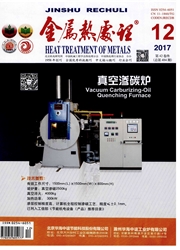

 中文摘要:
中文摘要:
为研究激光冲击强化7050铝合金薄板表面残余应力的形成机制,采用5种不同功率密度的激光束冲击加载7050铝合金薄板,利用PVDF(聚偏二氟乙烯)压电传感器测量激光冲击薄板试样的动态应变,利用X射线应力分析仪测量激光冲击后的残余应力分布,并借助三维显微系统观察激光冲击强化造成的表面微结构。结果表明,当激光功率密度为1.02GW/cm~2时,激光冲击引起的横向变形小;当激光功率密度为1.53GW/cm~2时,表面稀疏波与横向变形共同导致了试样最大残余主应力呈等双轴分布;当激光功率密度为1.98GW/cm~2和2.77GW/cm~2时,冲击区域中心比临近区域分别高出5.680μm和10.800μm,在来回反射的冲击波与表面稀疏波的共同作用下产生了残余应力洞现象;当激光功率密度为4.07GW/cm~2时,试样冲击区域产生了较大的塑性变形且比较平滑,最大残余主应力呈均匀分布。
 英文摘要:
英文摘要:
In order to study the formation mechanism of residual stress of 7050 aluminum alloy sheet surface by laser shock processing, the samples are processed by laser beam with five different power densities. The dynamic strain induced by laser shock processing sheet samples is measured by the polyvinylidene fluoride (PVDF) piezoelectric sensor. Residual stress distribution after laser shock processing is measured by the X-ray stress analyser. Three-dimensional microscopy system is used to observe the surface microstructure by laser shock processing. The results show that when the power density is 1.02 GW/cm2 , the transverse deformation induced by laser shock is small. When the power density is 1.53 GW/cm2 , both of the surface rarefaction wave and transverse deformation result in the equal-biaxial distribution of the maximum principal stress on the sample surface. When thepower densities are 1.98 GW/cm2 and 2.77 GW/cm2 , the center of the impact region is 5. 680 μm and 10. 800 μm higher than the adjacent part, respectively. The shock wave which is reflected back and forth and the surface rarefaction wave cause the occurrence of residual stress hole. When the power density is 4.07 GW/cm2 , the sample impact area has a large plastic deformation and is relatively smooth, the maximum residual principal stress distribution is uniform.
 同期刊论文项目
同期刊论文项目
 同项目期刊论文
同项目期刊论文
 期刊信息
期刊信息
